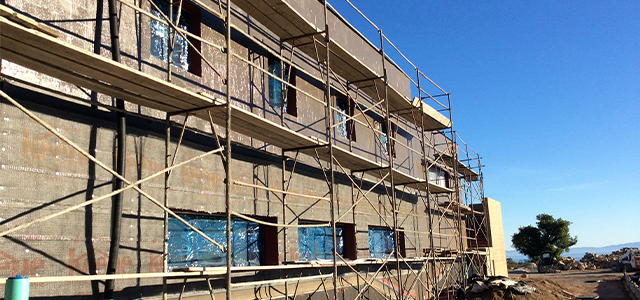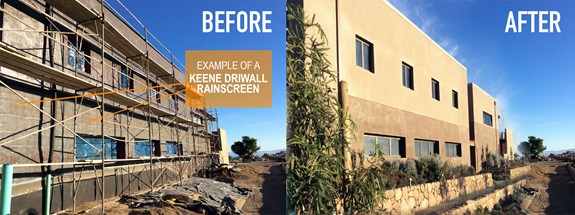
Exterior cladding systems can vary on the conceptual method of how they manage moisture. All exterior systems have a predetermined method, concept or strategy for control of rainwater. Regardless of the concept for moisture that is selected, research is indisputable that the primary cause of moisture related issues in the 1990’s was due to water finding its way through wall penetrations.
Exterior claddings, particularly stucco or plaster type systems can generally fit into one of the following three categories:
1. Barrier Concept: A system that is installed as a weather and water tight cladding on the outer most surface of the building. Water is not expected to penetrate this outer layer or barrier. These systems typically rely on 100 percent seal to the exterior elements. Sealants are a critical part of these systems and very little room is left for error.
This requires a stringent protocol, skilled trained installers, strict adherence to manufactures details and inspections by qualified individuals. Some barrier systems are designed as a thin waterproof coating and others are reliant on the thickness or mass of the wall. Other than mass wall construction, building codes require specific testing to prove the system prevents any bulk water entry. Examples of barrier systems:
- Concrete tilt up
- Single wyth masonry
- Barrier EIFS
- Sidings with no secondary water resistive barrier
- Sidings with no secondary barrier
- Skylights
2. Concealed Barrier: This is the most common conceptual method used for moisture management with exterior claddings for residential and most commercial work. The principal is to install the outer cladding as a weather tight cladding intended to deflect as much as 97% of the bulk rain or moisture. It is anticipated that incidental or small amounts of moisture will ultimately find its way past the exterior cladding or outer shell.
The secondary or “concealed” barrier is installed and integrated with flashings as a last barrier to prevent moisture from entering the cavity.
The most common concealed or secondary barrier is a code approved building paper or housewrap type product. The most important concept to follow is the “shingle fashion” installation of the concealed barrier and the flashings.
The concealed barrier concept is acceptable for all of North America, has been verified by independent testing. Examples are:
- Siding over water resistive barrier
- Plaster (stucco) systems and assemblies on framed walls
- Metal panels
- Stone veneers on framed walls
3. Rainscreen Concept: This system has been around for a couple decades and is gaining more market share due to a rash of leaking buildings. The rainscreen principal is an outer shell that stands off the primary structure. Significant amounts of water are anticipated to pass through the outer shell; these spaces allow for drainage and air movement for drying.
Another benefit to rainscreens is to displace negative pressures common on energy efficient building and air tight buildings. Almost all claddings can be adapted to rainscreen technology by using drainage mats, furring and/or double wall systems. Some commercial curtain wall systems can be classified as a “rainscreen” system. Pressure Equalized Rainscreen (PER) is a ventilated cladding system that intentionally allows free flowing air to rise and escape from behind the cladding.
Rainscreen claddings will add in the cost (though not high) it will add cost in the design, material and time to construct. The selection of which moisture management system to follow is the job of the design professional. Aesthetics, qualified labor, suitability and cost. Once selected the detailing of the exterior system is either the architect’s job or sublet to a qualified building envelope consultant. The installation of the system is the duty of the subcontractor and GC.

Keene Building Products can also be used in the consultation process, as we are the leaders in entangled net Rainscreen Systems that are also compliant with the ever-changing codes and life safety, i.e. NFPA 285.